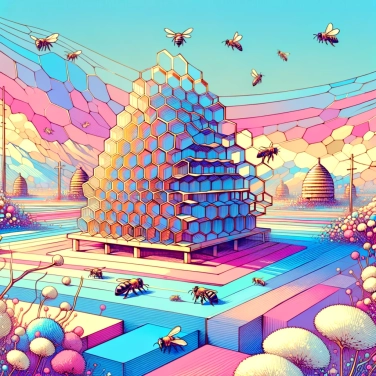Bees build hexagonal cells because this shape optimizes the storage space for honey and pollen, while using a minimal amount of beeswax, a precious resource for the colony.

Bees build their cells in the shape of hexagons because this shape allows them to fill available space without wasting it. Unlike round shapes that would leave wasted spaces, or squares and triangles that are less advantageous in terms of usable space, the hexagon enables bees to fit the maximum number of cells into a minimum of space. It is therefore the ideal and most efficient geometry for managing the storage of honey, pollen, and larvae, while also facilitating the daily life of the colony. Thousands of years before human engineers, bees had already found the best geometric solution to optimize their habitat.
The hexagonal shape naturally provides the cells with optimal strength against physical constraints, much like a honeycomb structure used by aerospace or construction engineers. Each side of the hexagon evenly distributes the forces and pressures exerted by the bees themselves, the wax, the honey, and the larvae. Compared to circular or square shapes, the hexagon allows for a balanced transmission of forces, thereby preventing breakage. This even distribution offers exceptional stability, helping the hive maintain its shape even under external vibrations or significant internal stresses, such as the constant movement of thousands of bees. Essentially, this structure is the natural equivalent of a very strong yet lightweight material.
Bees produce wax using special glands located under their abdomen, and this process requires a lot of energy. As a result, they naturally try to conserve their wax as much as possible. This is where the hexagonal shape makes all the difference: by constructing their cells in the form of adjoining hexagons, they achieve the maximum usable space for a minimum amount of wax used. Essentially, with square or round shapes, they would have more empty space to fill and would therefore unnecessarily consume much more wax. Thanks to this particular geometric shape, they optimize their work and their precious energy.
The regular hexagonal shape of the cells greatly facilitates the overall organization inside the hive. Each cell can accommodate eggs, larvae, storage of honey or pollen, allowing the bees to easily find their way and maintain true collective cohesion. Thanks to these regular cells, bees save time and energy when it comes time to clean and maintain each cell. They can easily inspect and repair damaged or dirty areas without wasting their precious energy. The result: a well-ordered, clean home, and a better-organized colony.
Bees use wax to create their hexagonal cells, but this wax, produced by their glands, requires a lot of energy: about 8 kg of honey is needed to produce just 1 kg of wax.
The structural robustness of hexagonal cells allows them to support several times their own weight in honey, pollen, and brood without the risk of collapsing or deforming.
A typical hive contains up to 50,000 worker bees capable of building nearly 100,000 hexagonal cells, each precisely oriented at an optimal angle for storage and reproduction.
The hexagon is the most efficient geometric shape in nature for maximizing storage space while using the minimum amount of material, allowing bees to save up to 30% of wax compared to a circular or square structure.
Yes, indirectly. By optimizing space and saving wax thanks to the hexagon, bees reduce their energy expenditure. This allows the colony to allocate more resources to other essential activities such as foraging, reproduction, and defense against pests.
No, man-made hives (such as frame hives) do not necessarily have to be hexagonal in shape. However, the internal frames often feature raised hexagonal patterns to assist the bees, indicating that mimicking nature remains beneficial for the colony.
A bee can produce a very small amount of wax during its lifetime, estimated at about 0.1 grams per worker bee. This demonstrates the importance of the optimization they exhibit by adopting a hexagonal configuration to save this precious material.
Although the hexagon is the dominant shape for storage cells, round or irregular cells may temporarily appear, especially during initial construction or when the hive adapts to spatial constraints. They usually end up becoming hexagonal for reasons of structural efficiency and clear distinction between neighboring cells.
Bees do not choose the square or the triangle because these geometric shapes would not optimize space as effectively while using a minimum of wax. The hexagon is the ideal shape because it combines the strength of a compact structure with the minimization of the material required.
The majority of the cells built by bees are indeed hexagonal because this shape optimizes space, uses less wax, and provides great stability. However, irregularities can occur depending on environmental circumstances or constraints within the hive.

No one has answered this quiz yet, be the first!' :-)
Question 1/4